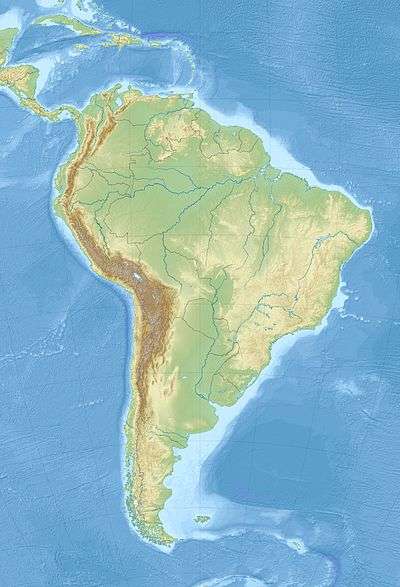Collón Curá Formation
The Collón Curá Formation (Spanish: Formación Collón Curá) is a Middle Miocene fossiliferous geological formation of the southern Neuquén Basin in northwestern Patagonia and the western Cañadón Asfalto Basin of central Patagonia, Argentina. The formation crops out from the southern Neuquén Province, the western Río Negro Province to the northern Chubut Province.
| Collón Curá Formation Stratigraphic range: Langhian-earliest Tortonian (typically Colloncuran) ~16.1–10.7 Ma | |
|---|---|
| Type | Geological formation |
| Sub-units | Tobaceo Las Bayas & Pilcaniyeú Ignimbrite Members |
| Underlies | Caleufú Formation & Chenqueniyeu Basalt (Neuquén Basin) El Mirador, Río Negro Formation & alluvium (Cañadón Asfalto Basin) |
| Overlies | Cerro Bandera, Huitrera & Cerro Petiso Formations, crystalline basement (Neuquén Basin) Ñirihuau, Lefipán & La Pava Formations (Cañadón Asfalto Basin) |
| Thickness | Up to 300 m (980 ft) |
| Lithology | |
| Primary | Tuff, sandstone |
| Other | Siltstone, marl, limestone, calcareous concretions, pumice |
| Location | |
| Coordinates | 40.0°S 70.8°W |
| Approximate paleocoordinates | 40.6°N 66.4°W |
| Region | Neuquén, Río Negro & Chubut Provinces |
| Country | |
| Extent | Cañadón Asfalto & Neuquén Basins |
| Type section | |
| Named for | Collón Curá River & Estancia Collón Curá |
| Named by | Yrigoyen |
| Location | Lácar Department |
| Year defined | 1969 |
| Coordinates | 40°04′56.6″S 70°51′55.3″W |
| Region | Neuquén Province |
| Country | |
| Thickness at type section | 50 m (160 ft) |
 Outcrop locations of the Collón Curá Formation | |
The formation, with a maximum thickness of 300 metres (980 ft), comprises tuffs and sandstones with minor siltstones, marls and limestones, deposited in a fluvial, deltaic and shallow to deep lacustrine environment in small basins separated by faults. The formation dates from the Langhian to earliest Tortonian epochs of the Middle to Late Miocene, typically Colloncuran.
The Collón Curá Formation is named after Estancia Collón Curá (1 on the map in the infobox) along the Collón Curá River (2), a tributary of the Limay River in the Río Negro watershed, and lends its name to the Colloncuran, one of the South American land mammal ages. The formation has provided many fossils of mammals, reptiles, among others the snake Waincophis australis, and the largest terror bird Kelenken guillermoi. The rodent Galileomys colloncurensis and the typothere Protypotherium colloncurensis were named after the formation.
Description
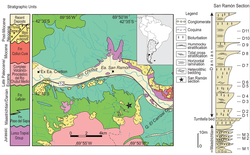

The strata of the Collón Curá Formation were first recognized by Roth in 1899, based on a 50 metres (160 ft) thick succession of grey tuffs in the valley of the Collón Curá River. In 1929, Groeber named the unit Colloncurense, separating the sediments from the older Santa Cruz Formation, that Roth had grouped in the same unit. Yrigoyen in 1969 formally defined the stratigraphic unit as Collón Curá Formation. The type section of the formation is on both sides on the Collón Curá River. The maximum recorded thickness in the Collón Curá river valley is 130 metres (430 ft).[1]
In the Chapelcó Range of the Neuquén Basin, the formation is unconformably overlain by the Caleufú Formation,[2] while basaltic lava flows[3] of the El Mirador Formation,[4] and Quaternary alluvium overly the Collón Curá Formation in the Cañadón Asfalto Basin.[5][6] In the Collón Curá valley, the formation covers Paleogene sediments of the Huitrera and Cerro Petiso Formations and in places overlying crystalline basement.[1] In other parts of the Neuquén Basin, the formation overlies the Early Miocene Cerro Bandera Formation or the Late Cretaceous Angostura Colorada Formation.[7][8] In the Cañadón Asfalto Basin, the Collón Curá Formation overlies the Ñirihuau Formation,[9] and in the area around the Chico River in the same basin, the formation overlies the La Pava Formation. In this location, the Collón Curá Formation is unconformably overlain by the Río Negro Formation.[10]
The oldest age for the formation has been given as 16.1 Ma,[11] and the top of the formation has been dated to 11 ± 1, and more precisely to 10.7 Ma.[1] 40Ar/39Ar analysis on amphibole crystals, collected from fresh pumice clasts, revealed an age of 14.86 ± 0.13 Ma for the middle section of the Collón Curá Formation in the Gastre Sub-basin of the Cañadón Asfalto Basin.[12] Earlier estimates based on K/Ar dating on biotite minerals of the Pilcaniyeú Ignimbrite Member were given as 15 Ma (1980) and 14.1 Ma (1990). Overall, the age of the formation ranges from Langhian to earliest Tortonian.[13]
Lithologies
In its type locality, the Collón Curá Formation is characterized by homogeneous greyish-yellow well-consolidated massive vitrocrystalline tuffs without visible sedimentary structures, but with calcareous concretions. The tuffaceous sediments contain pieces of white pumice with a vesicular character up to 2 millimetres (0.079 in) in size. The volcanic crystals in the tuff comprise andesine, hornblende and hypersthene in an argillaceous matrix. The concretions in the formation can reach up to 10 centimetres (3.9 in) in size and result from secondary diagenesis replacing the primary porosity of the sediments.[1]
Around the Río Chico in the Cañadón Asfalto Basin, the formation is about 300 metres (980 ft) thick and comprises siltstones, sandstones, marls and limestones.[10]
Depositional environment

The formation was deposited in a fluvial and lacustrine environment dominated by pyroclastic flows in small basins, separated by faults.[14] The sub-Andean region of Argentina went through a phase of marine transgression during the Middle Miocene, approximately 15 to 13 Ma.[15] The Collón Curá Formation shows growth strata in the Cañadón Asfalto Basin, indicating syn-tectonic deposition.[3] In this basin, the formation ranges from a shallow lacustrine setting in the basal section, a deep lacustrine system with deltaic facies in the middle and upper parts.[10] The Collón Curá Formation is correlated with the contemporaneous fluvial and lacustrine tuffaceous Chichinales Formation of the central Neuquén Basin.[16]
The Collón Curá Formation, together with the underlying Ñirihuau Formation in the Cañadón Asfalto Basin, was deposited in a fragmented, possibly by pull-apart tectonic activity,[17] foreland basin setting.[18]
The climate in the early middle Miocene was hot, a period known as the Middle Miocene Climatic Optimum. This thermal maximum was followed by a period of cooling, the Middle Miocene disruption, probably related to glacial growth and the reestablishment of the ice of the East Antarctic Ice Sheet. Atmospheric concentrations of CO2 are estimated to have dropped from about 300 to 140 ppm.[19]
Paleontological significance
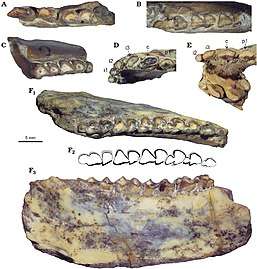
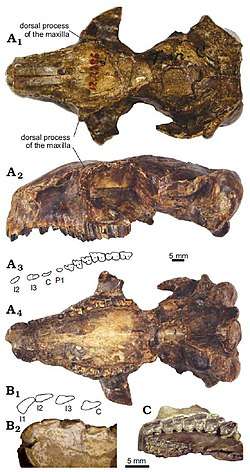

The mammal fauna of the Collón Curá Formation led researchers to establish the Colloncuran age in the SALMA classification, ranging from 15.5 to 13.8 Ma. This age, used in South America as subdivision for the Cenozoic, follows on the Friasian age, defined from the Chilean Río Frías Formation of the Aysén Basin and precedes the Laventan age, named after the Konzentrat-Lagerstätte La Venta pertaining to the Honda Group of the Upper Magdalena Valley of central Colombia.
The rodent Galileomys colloncurensis, and the typothere Protypotherium colloncurensis were named after the formation.[20]
The fossil mammal assemblage of the Collón Curá Formation represents a fauna preceding the evolution of the Caviidae. The oldest true caviid, Prodolichotis pridiana is known from the Villavieja and La Victoria Formations of La Venta, Colombia. Sister taxa of these caviids first appeared in the Colloncuran; Guiomys unica and Microcardiodon williensis, found in the Collón Curá Formation.[21] In alternative classification proposed in 2012 by Pérez and Pol, Guiomys is considered an optional early caviid, pushing back the lineage to the Colloncuran.[22]
Fossil content
| Group | Fossils | Images | Notes |
|---|---|---|---|
| Typotheria | Protypotherium colloncurensis | 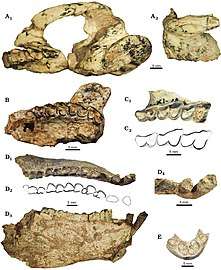 | |
| Protypotherium endiadys |  | ||
| Epipatriarchus sp., Interatherium sp. | |||
| Primates | Proteropithecia neuquenensis, Cebidae indet. | ||
| Rodents | Galileomys colloncurensis, Guiomys unica, Maruchito trilofodonte, cf. Microcardiodon williensis, Neosteiromys tordillense, Protacaremys denisae, Acarechimys sp., Alloiomys sp., Megastus sp., Neoreomys sp., Prolagostomus sp., Stichomys sp., Dasyproctidae indet., Echimyidae indet., Eocardiidae indet., Erethizontidae indet. | ||
| Hegetotheria | Hegetotherium sp., Pachyrukhos sp. | ||
| Sparassodonta | Patagosmilus goini, cf. Arctodictis sp. | ||
| Litopterna | Theosodon sp. | ||
| Cingulata | Proeutatus sp. | _(6859433704).jpg) | |
_(7005552541).jpg) | |||
_(7005553277).jpg) | |||
| Paraeucinepeltus raposeirasi, Peltephilus pumilus, Prozaedyus sp., Stenotatus sp., Stegotheriini indet. | |||
| Pilosa | ?Neotamandua australis | ||
| Paucituberculata | Abderites aisenense | ||
| Birds | Kelenken guillermoi | 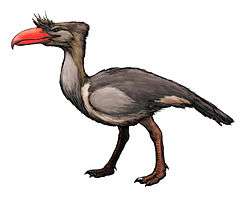 | |
| Reptiles | Chelonoidis gringorum, Waincophis australis, Boinae indet., Lacertilia indet. | ||
See also
| Wikimedia Commons has media related to Collón Curá Formation. |
- South American land mammal ages
- Cucaracha Formation of the Canal Zone, Panama
- Castilletes Formation of the Cocinetas Basin in northern Colombia
- Viche Formation of northern Ecuador
- Pebas Formation of the Amazon Basin
- Pisco Formation of the Pisco Basin in southern Peru
- Cura-Mallín Group of the western Neuquén Basin
References
- Escosteguy & Franchi, 2010, p.422
- Escosteguy & Franchi, 2010, p.418
- Echaurren et al., 2016, p.103
- Echaurren et al., 2016, p.102
- Echaurren et al., 2016, p.105
- Echaurren, 2017, p.102
- Geologic Map, 2007, p.112
- Prez & Massaferro, 2013, p.223
- Echaurren, 2017, p.96
- Río Chico Colloncuran at Fossilworks.org
- Di Pietro, 2016, p.47
- Estancia Collón Cura at Fossilworks.org
- Escosteguy & Franchi, 2010, p.423
- Figari et al., 2015, p.154
- Náñez & Malumián, 2019, p.193
- Geologic Map, 2007, p.49
- Dalla Salda & Franzese, 1987, p.11
- Echaurren, 2017, p.97
- Pearson & Palmer, 2000, p.699
- Vera et al., 2017, p.855
- Pérez & Pol, 2012, p.6
- Pérez & Pol, 2012, p.12
- Pilcaniyeu Viejo at Fossilworks.org
- Vera et al., 2017, p.848
- Chico River at Fossilworks.org
- Cañadon del Tordillo at Fossilworks.org
- Collón Cura River at Fossilworks.org
- Bondesio et al., 1980
- Estancia Campionario at Fossilworks.org
- Kay et al., 1998
- Silvestro et al., 2017, p.14
- Pardiñas, 1991
- RCH 018S at Fossilworks.org
- Vucetich & Kramarz, 2003
- Pérez, 2010
- Pérez & Vucetich, 2011
- Forasiepi & Carlini, 2010
- González Ruiz et al., 2011, p.569
- González Ruiz et al., 2013, p.323
- Comallo at Fossilworks.org
- Abello & Rubilar, 2012, p.180
- Bertelli et al., 2007
- Albino, 1996
Bibliography
- Geologic map
- Rodríguez, María F.; Héctor A. Leanza, and Matías Salvarredy Aranguren. 2007. Hoja Geológica 3969-II, NEUQUÉN, provincias del Neuquén, Río Negro y La Pampa 1:250,000, 1–165. Instituto de Geología y Recursos Minerales. Accessed 2019-02-23.
- Geology
- Dalla Salda, Luis, and Juan Franzese. 1987. Las megaestructuras del Macizo y Cordillera Norpatagónica argentina y la génesis de las cuencas volcano-sedimentarias terciarias. Andean Geology 31. 3–13. Accessed 2019-02-27.
- Echaurren González, Andrés. 2017. Evolución tectónica del sistema orogénico Andino en la Patagonia norte (42-44° S) (PhD thesis), 1–170. Universidad de Buenos Aires. Accessed 2019-02-27.
- Echaurren, A.; A. Folguera; G. Gianni; D. Orts; A. Tassara; A. Encinas; M. Giménez, and V. Valencia. 2016. Tectonic evolution of the North Patagonian Andes (41°–44° S) through recognition of syntectonic strata. Tectonophysics 677–678. 99–114. Accessed 2019-02-27.
- Escosteguy, Leonardo, and Mario Franchi. 2010. Estratigrafía de la región de Chapelco, Provincia del Neuquén. Revista de la Asociación Geológica Argentina 66. 418–429. Accessed 2019-02-27.
- Náñez, Carolina, and Norberto Malumián. 2019. Foraminíferos miocenos en la cuenca Neuquina, Argentina: implicancias estratigráficas y paleoambientales. Andean Geology 46. 183–210. Accessed 2019-02-27.
- Pearson, Paul N., and Martin R. Palmer. 2000. Atmospheric carbon dioxide concentrations over the past 60 million years. Nature 406. 695–699. Accessed 2019-02-27.
- Di Pietro, Pablo Federico. 2016. Geología de la zona del Cerro Bayo, Bajo de Gastre, Provincia de Chubut (B.S. thesis), 1–107. Universidad de Buenos Aires. Accessed 2019-02-27.
- Prez, Horacio, and Gabriela Massaferro. 2013. Geología y geomorfología del tramo superior del Arroyo Comallo, Río Negro. Contribuciones Científicas GÆA 26. 221–234. Accessed 2018-09-08.
- Paleontology
- Abello, María Alejandra, and David Rubilar Rogers. 2012. Revisión del género Abderites Ameghino, 1887 (Marsupialia, Paucituberculata). Ameghiniana 49. 164–184. Accessed 2019-02-15.
- Albino, A.M. 1996. Snakes from the Miocene of Patagonia (Argentina) Part I: The Booidea. Neues Jahrbuch für Geologie und Paläontologie, Abhandlungen 199. 417–434. Accessed 2019-02-27.
- Bertelli, Sara; Luis M. Chiappe, and Claudia Tambussi. 2007. A New Phorusrhacid (Aves: Cariamae) from the Middle Miocene of Patagonia, Argentina. Journal of Vertebrate Paleontology 27. 409–419. Accessed 2019-02-27.
- Bondesio, P.; J. Rabassa; R. Pascual; M.G. Vucetich, and G.J. Scillato Yané. 1980. La formación Collón-Curá de Pilcaniyeú Viejo y sus alrededores (Río Negro, República Argentina) su antiguedad y las condiciones ambientales según su distribución su litogenesis y sus vertebrados. Actas del Segundo Congreso Argentino de Paleontología y Bioestratigrafía y Primer Congreso Latinoamericano de Paleontología 3. 85–99.
- De Broin, F., and M. De la Fuente. 1993. Les tortues fossiles d'Argentine: synthese (The fossil turtles of Argentina: synthesis). Annales de Paléontologie (Invertebrés-Vertebrés) 79. 169–232. Accessed 2019-02-27.
- Forasiepi, A.M., and A.A. Carlini. 2010. A new thylacosmilid (Mammalia, Metatheria, Sparassodonta) from the Miocene of Patagonia, Argentina. Zootaxa 2552. 55–68. Accessed 2019-02-27.
- González Ruiz, Laureano Raúl; Flavio Góis; Martín Ricardo Ciancio, and Gustavo Juan Scillato Yané. 2013. Los Peltephilidae (Mammalia, Xenarthra) de la Formación Collón Curá (Colloncurense, Mioceno Medio), Argentina. Revista Brasileira de Paleontologia 16. 319–330. Accessed 2019-02-27.
- González Ruiz, Laureano Raúl; Alfredo Eduardo Zurita; Gustavo Juan Scillato Yané; Martín Zamorano, and Marcelo Fabián Tejedor. 2011. Un nuevo Glyptodontidae (Mammalia, Xenarthra, Cingulata) del Mioceno de Patagonia (Argentina) y comentarios acerca de la sistemática de los gliptodontes "friasenses". Revista Mexicana de Ciencias Geológicas 28. 566–579. Accessed 2019-02-27.
- Kay, R.F.; D. Johnson, and J. Meldrum. 1998. A new Pitheciin Primate from the Middle Miocene. American Journal of Primatology 45. 317–336. Accessed 2019-02-27.
- Kramarz, Alejandro; Alberto Garrido; Analía Forasiepi; Mariano Bond, and Claudia Tambussi. 2005. Estratigrafia y vertebrados (Aves y Mammalia) de la Formación Cerro Bandera, Mioceno Temprano de la Provincia del Neuquén, Argentina. Revista Geológica de Chile 32. 273–291. Accessed 2017-10-20.
- McDonald, H.G.; S.F. Vizcaíno, and M.S. Bargo. 2008. Skeletal anatomy and the fossil history of the Vermilingua, 64–78. S. F. Vizcaíno, W. J. Loughry (eds.), The Biology of the Xenarthra. Accessed 2019-02-27.
- Oriozabala, C.; J. Sterli, and L. González Ruiz. 2018. Morphology of the mid-sized tortoises (Testudines: Testudinidae) from the Middle Miocene of Northwestern Chubut. Ameghiniana 55. 30–54. Accessed 2019-02-27.
- Pardiñas, U.F.J. 1991. Primer registro de primates y otros vertebrados para la Formacion Collón Curá (Mioceno medio) del Neuquén, Argentina (First record of primates and other vertebrates from the Collón Curá Formation (middle Miocene) of Neuquén, Argentina). Ameghiniana 28. 197–199. Accessed 2019-02-27.
- Pérez, M.E., and M.G. Vucetich. 2011. A new Extinct Genus of Cavioidea (Rodentia, Hystricognathi) from the Miocene of Patagonia (Argentina) and the Evolution of Cavoid Mandibular Morphology. Journal of Mammalian Evolution 18. 163–183. Accessed 2019-02-27.
- Pérez, M.E. 2010. A new rodent (Cavioidea, Hystricognathi) from the middle Miocene of Patagonia, mandibular homologies, and the origin of the crown group Cavioidea sensu stricto. Journal of Vertebrate Paleontology 30. 1848–1859. Accessed 2019-02-27.
- Silvestro, Daniele; Marcelo F. Tejedor; Martha L. Serrano Serrano; Oriane Loiseau; Victor Rossier; Jonathan Rolland; Alexander Zizka; Alexandre Antonelli, and Nicolas Salamin. 2017. Evolutionary history of New World monkeys revealed by molecular and fossil data. BioRxiv _. 1–32. Accessed 2017-09-24.
- Vera Nardoni, Bárbara; Marcelo Reguero, and Laureano González Ruiz. 2017. The Interatheriinae notoungulates from the middle Miocene Collón Curá Formation in Argentina. Acta Palaeontologica Polonica 62. 845–863. Accessed 2019-02-27.
- Vucetich, M.G., and A.G. Kramarz. 2003. New Miocene rodents from Patagonia (Argentina) and their bearing on the early radiation of the Octodontoids (Hystricognathi). Journal of Vertebrate Paleontology 23. 435–444. Accessed 2019-02-27.
- Vucetich, M.G.; M.M. Mazzoni, and U.F.J. Pardiñas. 1993. Los roedores de la Formación Collón Curá (Mioceno Medio), y la ignimbrita Pilcaniyeú, Cañadón del Tordillo, Neuquén. Ameghiniana 30. 361–381. Accessed 2019-02-27.
